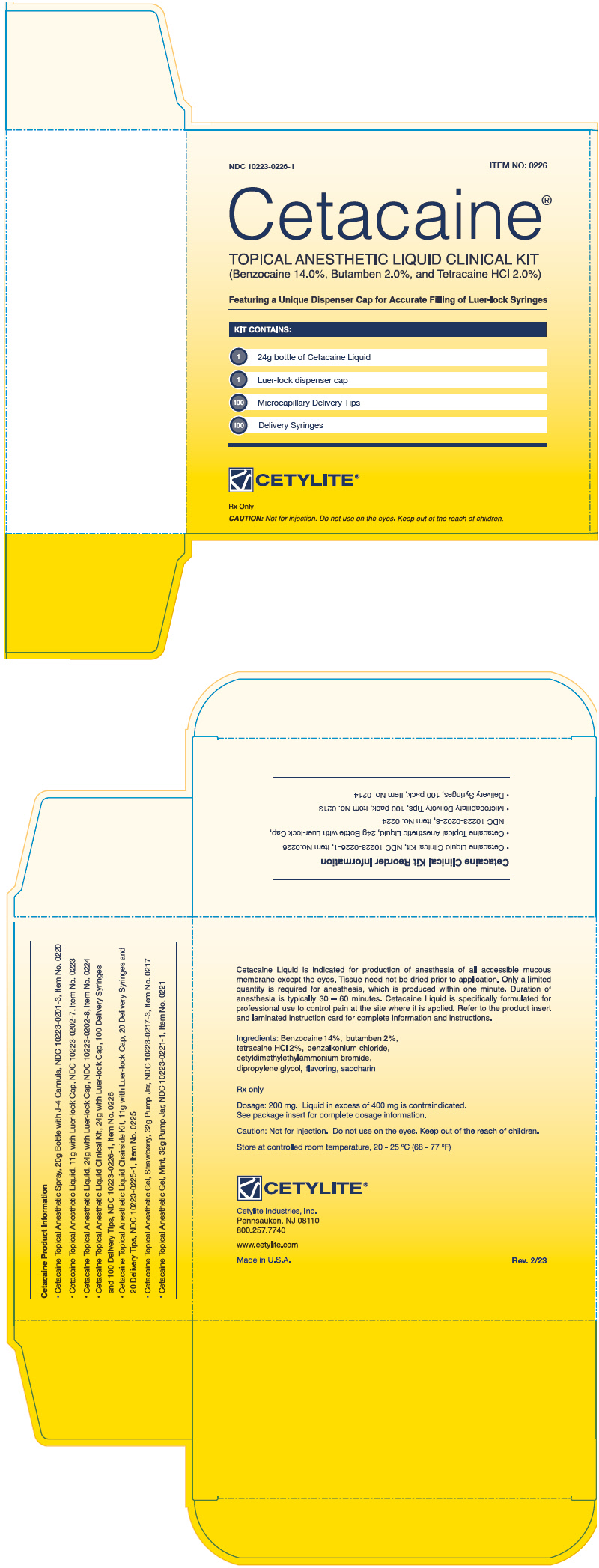Cetacaine Anesthetic
Cetacaine Topical Anesthetic Spray and Liquid
89f262a4-a41b-41d7-806b-61b9b89542f0
HUMAN PRESCRIPTION DRUG LABEL
May 11, 2023
Cetylite Industries, Inc.
DUNS: 001283704
Products 3
Detailed information about drug products covered under this FDA approval, including NDC codes, dosage forms, ingredients, and administration routes.
Benzocaine, Butamben, and Tetracaine Hydrochloride
Product Details
FDA regulatory identification and product classification information
FDA Identifiers
Product Classification
Product Specifications
INGREDIENTS (7)
Benzocaine, Butamben, and Tetracaine Hydrochloride
Product Details
FDA regulatory identification and product classification information
FDA Identifiers
Product Classification
Product Specifications
INGREDIENTS (7)
Benzocaine, Butamben, and Tetracaine Hydrochloride
Product Details
FDA regulatory identification and product classification information
FDA Identifiers
Product Classification
Product Specifications
INGREDIENTS (7)
Drug Labeling Information
PACKAGE LABEL.PRINCIPAL DISPLAY PANEL
PRINCIPAL DISPLAY PANEL - 24 g Bottle Kit
NDC 10223-0226-1
ITEM NO: 0226
Cetacaine®
TOPICAL ANESTHETIC LIQUID CLINICAL KIT
(Benzocaine 14.0%, Butamben 2.0%, and Tetracaine HCl 2.0%)
Featuring a Unique Dispenser Cap for Accurate Filling of Luer-lock Syringes
KIT CONTAINS:
1 24g bottle of Cetacaine Liquid
1 Luer-lock dispenser cap
100 Microcapillary Delivery Tips
100 Delivery Syringes
CETYLITE®
Rx Only
CAUTION: Not for injection. Do not use on the eyes. Keep out of reach of children.

DOSAGE & ADMINISTRATION SECTION
Dosage and Administration
Cetacaine Spray should be applied for approximately one second or less for normal anesthesia. Only a limited quantity of Cetacaine is required for anesthesia. Spray in excess of two seconds is contraindicated. Each one-second spray contains an average of 200 mg of product, not including propellant.
To apply, insert the cannula firmly onto the protruding plastic stem on the bottle and press the cannula forward to actuate the spray valve. The cannula may be removed and reinserted as many times as required for cleaning, or sterilization, and is autoclavable.
Cetacaine Liquid
Apply 200 mg liquid (approximately 0.2 mL) directly to tissue. Liquid in excess of 400 mg (approximately 0.4 mL) is contraindicated.
To apply, remove and discard the shipping cap from the bottle. Replace it with the supplied Luer-lock cap. Caution: Do not over-tighten. Remove small cap from luer-lock port, retaining it for replacement after use. Port allows for a single dip of a cotton or brush applicator for application directly to accessible mucous membrane. For application into periodontal pockets, Cetylite Luer-lock syringes and Microcapillary Delivery Tips are recommended. Cetylite Syringes are clearly marked in (4) 0.1 mL increments. To fill, attach syringe to port by gently twisting clockwise until secure. Invert and draw desired amount of liquid into the syringe. Remove filled syringe and attach Microcapillary Delivery Tip to the syringe. Tip may be bent to improve access. Apply drop-wise to accessible mucous membrane (such as buccal and lingual sulcus) by slowly depressing the syringe plunger. Discard all applicators after use.
An appropriate pediatric dosage has not been established for Cetacaine Spray or Cetacaine Liquid.
Dosages should be reduced in the debilitated elderly, acutely ill, and very young patients (i.e., children 2 years and older).
Do not use Cetacaine Spray or Cetacaine Liquid to treat infants or children younger than 2 years.
Tissue need not be dried prior to application of Cetacaine. Cetacaine should be applied directly to the site where pain control is required. Anesthesia is produced within one minute with an approximate duration of thirty minutes. Each 200 mg dose of Cetacaine (Spray or Liquid) contains 28 mg of benzocaine, 4 mg of butamben and 4 mg of tetracaine HCl.
INFORMATION FOR PATIENTS SECTION
PATIENT COUNSELING INFORMATION
Inform patients that use of local anesthetics may cause methemoglobinemia, a serious condition that must be treated promptly. Advise patients or caregivers to stop use and seek immediate medical attention if they or someone in their care experience the following signs or symptoms: pale, gray, or blue colored skin (cyanosis); headache; rapid heart rate; shortness of breath; lightheadedness; or fatigue.
Hypersensitivity Reactions
Unpredictable adverse reactions (i.e. hypersensitivity, including anaphylaxis) are extremely rare.
Localized allergic reactions may occur after prolonged or repeated use of any aminobenzoate anesthetic. The most common adverse reaction caused by local anesthetics is contact dermatitis characterized by erythema and pruritus that may progress to vesiculation and oozing. This occurs most commonly in patients following prolonged self-medication, which is contraindicated. If rash, urticaria, edema, or other manifestations of allergy develop during use, the drug should be discontinued. To minimize the possibility of a serious allergic reaction, Cetacaine preparations should not be applied for prolonged periods except under continual supervision. Dehydration of the epithelium or an escharotic effect may also result from prolonged contact.
Use in Pregnancy
Safe use of Cetacaine has not been established with respect to possible adverse effects upon fetal development. Therefore, Cetacaine should not be used during early pregnancy, unless in the judgement of a physician, the potential benefits outweigh the unknown hazards. Routine precaution for the use of any topical anesthetic should be observed when Cetacaine is used.
